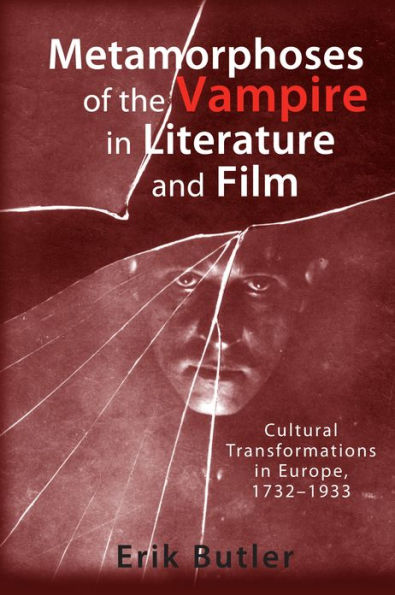Metamorphoses of the Vampire in Literature and Film: Cultural Transformations in Europe, 1732-1933
For the last three hundred years, fictions of the vampire have fed off anxieties about cultural continuity. Though commonly represented as a parasitic aggressor from without, the vampire is in fact anative of Europe, and its "metamorphoses," to quote Baudelaire, a distorted image of social transformation. Because the vampire grows strong whenever and wherever traditions weaken, its representations have multiplied with every political, economic, and technological revolution from the eighteenth century on. Today, in the age of globalization, vampire fictions are more virulent than ever, and themonster enjoys hunting grounds as vast as the international market.
Metamorphoses of the Vampire explains why representations of vampirism began in the eighteenth century, flourished inthe nineteenth, and came to eclipse nearly all other forms of monstrosity in the early twentieth century. Many of the works by French and German authors discussed here have never been presented to students and scholars in the English-speaking world. While there are many excellent studies that examine Victorian vampires, the undead in cinema, contemporary vampire fictions, and the vampire in folklore, until now no work has attempted to account for the unifying logic that underlies the vampire's many and often apparently contradictory forms.
Erik Butler holds a PhD from Yale University and has taught at Emory University and Swarthmore College. His publications include The Bellum Gramaticale and the Rise of European Literature (2010) and a translation with commentary of Regrowth (Vidervuks) by the Soviet Jewish author Der Nister (2011).
1017741961
Metamorphoses of the Vampire explains why representations of vampirism began in the eighteenth century, flourished inthe nineteenth, and came to eclipse nearly all other forms of monstrosity in the early twentieth century. Many of the works by French and German authors discussed here have never been presented to students and scholars in the English-speaking world. While there are many excellent studies that examine Victorian vampires, the undead in cinema, contemporary vampire fictions, and the vampire in folklore, until now no work has attempted to account for the unifying logic that underlies the vampire's many and often apparently contradictory forms.
Erik Butler holds a PhD from Yale University and has taught at Emory University and Swarthmore College. His publications include The Bellum Gramaticale and the Rise of European Literature (2010) and a translation with commentary of Regrowth (Vidervuks) by the Soviet Jewish author Der Nister (2011).
Metamorphoses of the Vampire in Literature and Film: Cultural Transformations in Europe, 1732-1933
For the last three hundred years, fictions of the vampire have fed off anxieties about cultural continuity. Though commonly represented as a parasitic aggressor from without, the vampire is in fact anative of Europe, and its "metamorphoses," to quote Baudelaire, a distorted image of social transformation. Because the vampire grows strong whenever and wherever traditions weaken, its representations have multiplied with every political, economic, and technological revolution from the eighteenth century on. Today, in the age of globalization, vampire fictions are more virulent than ever, and themonster enjoys hunting grounds as vast as the international market.
Metamorphoses of the Vampire explains why representations of vampirism began in the eighteenth century, flourished inthe nineteenth, and came to eclipse nearly all other forms of monstrosity in the early twentieth century. Many of the works by French and German authors discussed here have never been presented to students and scholars in the English-speaking world. While there are many excellent studies that examine Victorian vampires, the undead in cinema, contemporary vampire fictions, and the vampire in folklore, until now no work has attempted to account for the unifying logic that underlies the vampire's many and often apparently contradictory forms.
Erik Butler holds a PhD from Yale University and has taught at Emory University and Swarthmore College. His publications include The Bellum Gramaticale and the Rise of European Literature (2010) and a translation with commentary of Regrowth (Vidervuks) by the Soviet Jewish author Der Nister (2011).
Metamorphoses of the Vampire explains why representations of vampirism began in the eighteenth century, flourished inthe nineteenth, and came to eclipse nearly all other forms of monstrosity in the early twentieth century. Many of the works by French and German authors discussed here have never been presented to students and scholars in the English-speaking world. While there are many excellent studies that examine Victorian vampires, the undead in cinema, contemporary vampire fictions, and the vampire in folklore, until now no work has attempted to account for the unifying logic that underlies the vampire's many and often apparently contradictory forms.
Erik Butler holds a PhD from Yale University and has taught at Emory University and Swarthmore College. His publications include The Bellum Gramaticale and the Rise of European Literature (2010) and a translation with commentary of Regrowth (Vidervuks) by the Soviet Jewish author Der Nister (2011).
16.49
In Stock
5
1

Metamorphoses of the Vampire in Literature and Film: Cultural Transformations in Europe, 1732-1933
238
Metamorphoses of the Vampire in Literature and Film: Cultural Transformations in Europe, 1732-1933
238
16.49
In Stock

Product Details
| ISBN-13: | 9781571138514 |
|---|---|
| Publisher: | Boydell & Brewer Group Ltd |
| Publication date: | 03/01/2010 |
| Series: | Studies in German Literature Linguistics and Culture , #54 |
| Sold by: | Barnes & Noble |
| Format: | eBook |
| Pages: | 238 |
| File size: | 2 MB |
| Age Range: | 18 Years |
About the Author
From the B&N Reads Blog
